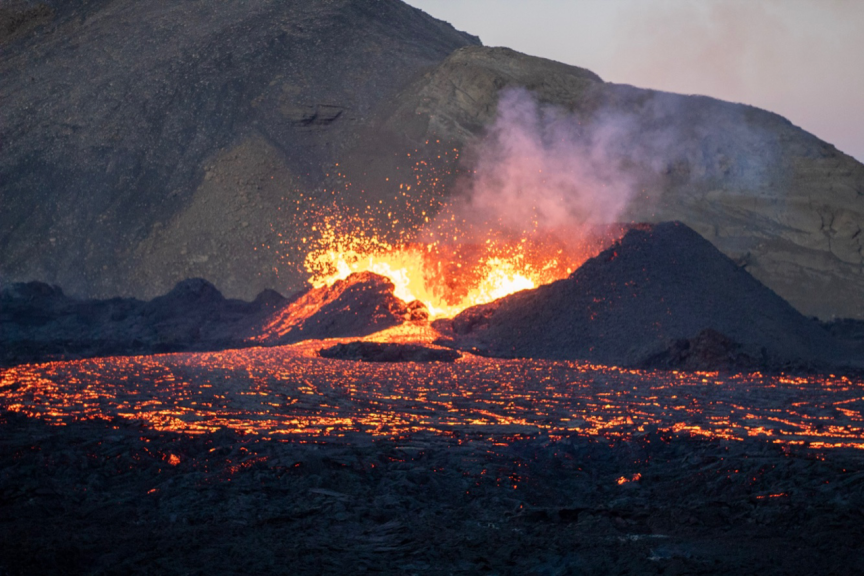
Lead supervisor: Sally Gibson, Earth Sciences
Co-supervisor: Simon Matthews, University of Iceland
Brief summary:
Melts erupted at oceanic islands are diverse and provide key constraints on deep Earth proceses
Importance of the area of research concerned:
Basaltic melts erupted at ocean islands provide a unique insight into the composition of Earth’s deep interior. Elemental and isotopic studies of melts from ocean-islands have shown that the convecting mantle is lithologically heterogeneous and contains subducted oceanic lithosphere that has been ‘stirred’ into the convecting mantle over geological time. This high-density material is widely thought to have accumulated at the core mantle boundary prior to entrainment by upwelling mantle plumese.g.1, and significantly, may lead to plume cooling and a decrease in melt productivity at ocean islands. Estimates of the amount of subducted material that is recycled back to Earth’s surface are primarily based on geochemical data but are highly variable, i.e. models of isotope systems (Pb, Os and Fe) often generate conflicting results to those from minor elements in olivine (Ni, Mn, Ca). Moreover, many of these estimates are inconsistent with the findings of theoretical models that have examined the capacity of mantle plumes to entrain high-density material, and have major implications for our understanding of global element cycling and periodic variations in melt flux at ocean islands.
Project summary :
This project seeks to provide internally consistent models of geochemical datasets from ocean-island volcanoes with physical data for melting and entrainment. It will innovate by combining new geochemical proxies for subducted oceanic lithosphere with data from the published literature to improve constraints on the amount of material that is being recycled and erupted at our planet’s surface by modern volcanoes. Case studies will involve some of the world’s most volcanically active regions, Iceland, Azores and Galapagos. These have contrasting tectonic settings; Icelandic volcanism is driven by an on-axis mantle plume whereas the Azores and Galapagos mantle plumes are off-axis. The mantle potential temperatures of the hotspots are similar but the thicker lithosphere at Galapagos permits less decompression melting and overprinting of signatures generated by ‘deep’ eclogitic melts2.
What will the student do?:
The student will undertake fieldwork under the guidance of the supervisors in order to collect a suite of samples from a range of Icelandic volcanoes that have geochemical signatures of recycled material. This sample set will be supplemented by suitable material from the Azores and Galapagos that already exists in the supervisors’ collections. The samples will be analysed using high-precision analytical techniques available in the Department of Earth Sciences at the University of Cambridge. New modelling approaches for predicting the compositions of melts will be applied and further developed within the pyMelt software, which combines thermodynamic data with the compositions of naturally occurring magmas3. This will build a more quantitative understanding of the controls of mantle temperature, mantle composition and melting depth on the differences in compositions and volumes of lavas erupted at ocean islands. The results will be compared with those from numerical models focused on the physics of plume entrainment in order to generate physically and chemically constrained models of volcanism at ocean islands.
References - references should provide further reading about the project:
1. Gleeson, M., Soderman, C., Matthews, S., Cottaar, S. & Gibson, S. Geochemical Constraints on the Structure of the Earth’s Deep Mantle and the Origin of the LLSVPs. Geochemistry, Geophysics, Geosystems 22, e2021GC009932 (2021).
2. Gibson, S. A. & Richards, M. A. Delivery of deep-sourced, volatile-rich plume material to the global ridge system. Earth and Planetary Science Letters 499, 205–218 (2018).
3. Matthews, S., Wong, K. & Gleeson, M. pyMelt: An extensible Python engine for mantle melting calculations. Volcanica 5, 469–475 (2022).
Applying
You can find out about applying for this project on the Department of Earth Sciences page.